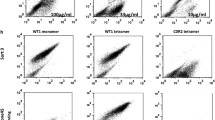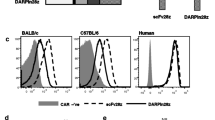Abstract
B7H6 is emerging as a promising tumor antigen that is known to be expressed on a wide array of tumors and is reported to stimulate anti-tumor responses from the immune system. As such, B7H6 presents a good target for tumor-specific immunotherapies. B7H6-specific chimeric antigen receptors (CAR) based on a murine antibody showed successful targeting and elimination of tumors expressing B7H6. However, mouse single chain variable fragments (scFvs) have the potential to induce host anti-CAR responses that may limit efficacy, so human scFvs specific for B7H6 were selected by yeast surface display. In this study, we validate the functionality of these human scFvs when formatted into chimeric antigen receptors. The data indicate that T cells expressing these B7H6-specific human scFvs as CARs induced potent anti-tumor activity in vitro and in vivo against tumors expressing high amounts of B7H6. Importantly, these human scFv-based CARs are sensitive to changes in B7H6 expression which may potentially spare non-tumor cells that express B7H6 and provides the foundation for future clinical development.





Similar content being viewed by others
Abbreviations
- B6:
-
C57BL/6
- CAR:
-
Chimeric antigen receptor
- CYP:
-
Cytoplasmic
- H:
-
Hinge
- MFI:
-
Mean fluorescent intensity
- NK:
-
Natural killer
- scFv:
-
Single-chain fragment variable
- TM:
-
Transmembrane
References
Brandt CS, Baratin M, Yi EC, Kennedy J, Gao Z, Fox B, Haldeman B, Ostrander CD, Kaifu T, Chabannon C, Moretta A, West R, Xu W, Vivier E, Levin SD (2009) The B7 family member B7-H6 is a tumor cell ligand for the activating natural killer cell receptor NKp30 in humans. J Exp Med 206(7):1495–1503. https://doi.org/10.1084/jem.20090681
Zhang T, Wu MR, Sentman CL (2012) An NKp30-based chimeric antigen receptor promotes T cell effector functions and antitumor efficacy in vivo. J Immunol 189(5):2290–2299. https://doi.org/10.4049/jimmunol.1103495
Zhang X, Zhang G, Qin Y, Bai R, Huang J (2014) B7-H6 expression in non-small cell lung cancers. Int J Clin Exp Pathol 7(10):6936–6942
Chen XJ, Shen J, Zhang GB, Chen WC (2014) B7-H6 protein expression has no prognostic significance in human gastric carcinoma. Pathol Oncol Res 20(1):203–207. https://doi.org/10.1007/s12253-013-9686-1
Zhou Y, Xu Y, Chen L, Xu B, Wu C, Jiang J (2015) B7-H6 expression correlates with cancer progression and patient’s survival in human ovarian cancer. Int J Clin Exp Pathol 8(8):9428–9433
Wu F, Wang J, Ke X (2016) Knockdown of B7-H6 inhibits tumor progression and enhances chemosensitivity in B-cell non-Hodgkin lymphoma. Int J Oncol 48(4):1561–1570. https://doi.org/10.3892/ijo.2016.3393
Li Y, Wang Q, Mariuzza RA (2011) Structure of the human activating natural cytotoxicity receptor NKp30 bound to its tumor cell ligand B7-H6. J Exp Med 208(4):703–714. https://doi.org/10.1084/jem.20102548
Matta J, Baratin M, Chiche L, Forel JM, Cognet C, Thomas G, Farnarier C, Piperoglou C, Papazian L, Chaussabel D, Ugolini S, Vely F, Vivier E (2013) Induction of B7-H6, a ligand for the natural killer cell-activating receptor NKp30, in inflammatory conditions. Blood 122(3):394–404. https://doi.org/10.1182/blood-2013-01-481705
Pesce S, Tabellini G, Cantoni C, Patrizi O, Coltrini D, Rampinelli F, Matta J, Vivier E, Moretta A, Parolini S, Marcenaro E (2015) B7-H6-mediated downregulation of NKp30 in NK cells contributes to ovarian carcinoma immune escape. Oncoimmunology 4(4):e1001224. https://doi.org/10.1080/2162402X.2014.1001224
Schlecker E, Fiegler N, Arnold A, Altevogt P, Rose-John S, Moldenhauer G, Sucker A, Paschen A, von Strandmann EP, Textor S, Cerwenka A (2014) Metalloprotease-mediated tumor cell shedding of B7-H6, the ligand of the natural killer cell-activating receptor NKp30. Cancer Res 74(13):3429–3440. https://doi.org/10.1158/0008-5472.CAN-13-3017
Sadelain M, Brentjens R, Riviere I (2013) The basic principles of chimeric antigen receptor design. Cancer Discov 3(4):388–398. https://doi.org/10.1158/2159-8290.CD-12-0548
Gacerez AT, Arellano B, Sentman CL (2016) How chimeric antigen receptor design affects adoptive T cell therapy. J Cell Physiol 231(12):2590–2598. https://doi.org/10.1002/jcp.25419
Wu MR, Zhang T, DeMars LR, Sentman CL (2015) B7H6-specific chimeric antigen receptors lead to tumor elimination and host antitumor immunity. Gene therapy 22(8):675–684. https://doi.org/10.1038/gt.2015.29
Hua CK, Gacerez AT, Sentman CL, Ackerman ME (2017) Development of unique cytotoxic chimeric antigen receptors based on human scFv targeting B7H6. Protein Eng Design Sel: PEDS 30(10):713–721. https://doi.org/10.1093/protein/gzx051
Feldhaus MJ, Siegel RW, Opresko LK, Coleman JR, Feldhaus JM, Yeung YA, Cochran JR, Heinzelman P, Colby D, Swers J, Graff C, Wiley HS, Wittrup KD (2003) Flow-cytometric isolation of human antibodies from a nonimmune Saccharomyces cerevisiae surface display library. Nat Biotechnol 21(2):163–170. https://doi.org/10.1038/nbt785
Joyce MG, Tran P, Zhuravleva MA, Jaw J, Colonna M, Sun PD (2011) Crystal structure of human natural cytotoxicity receptor NKp30 and identification of its ligand binding site. Proc Natl Acad Sci USA 108(15):6223–6228. https://doi.org/10.1073/pnas.1100622108
Fitzer-Attas CJ, Schindler DG, Waks T, Eshhar Z (1998) Harnessing Syk family tyrosine kinases as signaling domains for chimeric single chain of the variable domain receptors: optimal design for T cell activation. J Immunol 160(1):145–154
Hombach A, Heuser C, Gerken M, Fischer B, Lewalter K, Diehl V, Pohl C, Abken H (2000) T cell activation by recombinant FcepsilonRI gamma-chain immune receptors: an extracellular spacer domain impairs antigen-dependent T cell activation but not antigen recognition. Gene Therapy 7(12):1067–1075. https://doi.org/10.1038/sj.gt.3301195
Hudecek M, Lupo-Stanghellini MT, Kosasih PL, Sommermeyer D, Jensen MC, Rader C, Riddell SR (2013) Receptor affinity and extracellular domain modifications affect tumor recognition by ROR1-specific chimeric antigen receptor T cells. Clin Cancer Res 19(12):3153–3164. https://doi.org/10.1158/1078-0432.CCR-13-0330
Kunkele A, Johnson AJ, Rolczynski LS, Chang CA, Hoglund V, Kelly-Spratt KS, Jensen MC (2015) Functional tuning of CARs reveals signaling threshold above which CD8 + CTL antitumor potency is attenuated due to cell Fas-FasL-Dependent AICD. Cancer Immunol Res 3(4):368–379. https://doi.org/10.1158/2326-6066.CIR-14-0200
Guest RD, Hawkins RE, Kirillova N, Cheadle EJ, Arnold J, O’Neill A, Irlam J, Chester KA, Kemshead JT, Shaw DM, Embleton MJ, Stern PL, Gilham DE (2005) The role of extracellular spacer regions in the optimal design of chimeric immune receptors: evaluation of four different scFvs and antigens. J Immunother 28(3):203–211
Chmielewski M, Hombach AA, Abken H (2011) CD28 cosignalling does not affect the activation threshold in a chimeric antigen receptor-redirected T-cell attack. Gene Therapy 18(1):62–72. https://doi.org/10.1038/gt.2010.127
Haso W, Lee DW, Shah NN, Stetler-Stevenson M, Yuan CM, Pastan IH, Dimitrov DS, Morgan RA, FitzGerald DJ, Barrett DM, Wayne AS, Mackall CL, Orentas RJ (2013) Anti-CD22-chimeric antigen receptors targeting B-cell precursor acute lymphoblastic leukemia. Blood 121(7):1165–1174. https://doi.org/10.1182/blood-2012-06-438002
Hudecek M, Sommermeyer D, Kosasih PL, Silva-Benedict A, Liu L, Rader C, Jensen MC, Riddell SR (2015) The nonsignaling extracellular spacer domain of chimeric antigen receptors is decisive for in vivo antitumor activity. Cancer Immunol Res 3(2):125–135. https://doi.org/10.1158/2326-6066.CIR-14-0127
Liu X, Jiang S, Fang C, Yang S, Olalere D, Pequignot EC, Cogdill AP, Li N, Ramones M, Granda B, Zhou L, Loew A, Young RM, June CH, Zhao Y (2015) Affinity-tuned ErbB2 or EGFR chimeric antigen receptor T cells exhibit an increased therapeutic index against tumors in mice. Cancer Res 75(17):3596–3607. https://doi.org/10.1158/0008-5472.CAN-15-0159
Lynn RC, Feng Y, Schutsky K, Poussin M, Kalota A, Dimitrov DS, Powell DJ Jr (2016) High-affinity FRbeta-specific CAR T cells eradicate AML and normal myeloid lineage without HSC toxicity. Leukemia 30(6):1355–1364. https://doi.org/10.1038/leu.2016.35
Watanabe K, Terakura S, Martens AC, van Meerten T, Uchiyama S, Imai M, Sakemura R, Goto T, Hanajiri R, Imahashi N, Shimada K, Tomita A, Kiyoi H, Nishida T, Naoe T, Murata M (2015) Target antigen density governs the efficacy of anti-CD20-CD28-CD3 zeta chimeric antigen receptor-modified effector CD8 + T cells. J Immunol 194(3):911–920. https://doi.org/10.4049/jimmunol.1402346
Boomer JS, Green JM (2010) An enigmatic tail of CD28 signaling. Cold Spring Harbor Perspect Biol 2(8):a002436. https://doi.org/10.1101/cshperspect.a002436
Upshaw JL, Leibson PJ (2006) NKG2D-mediated activation of cytotoxic lymphocytes: unique signaling pathways and distinct functional outcomes. Semin Immunol 18(3):167–175. https://doi.org/10.1016/j.smim.2006.03.001
Wang C, Lin GH, McPherson AJ, Watts TH (2009) Immune regulation by 4-1BB and 4-1BBL: complexities and challenges. Immunol Rev 229(1):192–215. https://doi.org/10.1111/j.1600-065X.2009.00765.x
Acknowledgements
The authors thank the staff of the Center for Comparative Medicine Research for assistance with animal care and the Shared Molecular Biology Resource at the Norris Cotton Cancer Center for sequencing. The authors also thank the National Cancer Institute Biological Resource Branch for recombinant human IL-2.
Funding
This work was supported by funds from The Elmer R. Pfefferkorn and Allan U. Munck Education and Research Fund, the Center of Biomedical Research Excellence (8P30GM103415), and the Center for Synthetic Immunity.
Author information
Authors and Affiliations
Contributions
All authors have contributed to the design and interpretation of experiments and the writing and editing of the manuscript. Albert T. Gacerez was responsible for acquisition of data.
Corresponding author
Ethics declarations
Conflict of interest
All authors have patent applications in antibody-based therapies and cell engineering. These conflicts are managed under the policies of Dartmouth College.
Ethical Approval and ethical standards
All procedures involving mice were in accordance with the ethical standards set forth by the Dartmouth College’s Institution Animal Care and Use Committee.
Animal source
C57BL/6 (B6) mice from Charles River.
Cell line authentication
ATCC authenticated K562 on August 25, 2016 and SH-SY5Y on October 27, 2016. Murine cell lines were obtained from 2001 to 2006. RMA cell lines were obtained from Michael Bennett (UT Southwestern Medical Center) and B16F10 cell lines were obtained from Richard Barth (Geisel School of Medicine at Dartmouth).
Rights and permissions
About this article
Cite this article
Gacerez, A.T., Hua, C.K., Ackerman, M.E. et al. Chimeric antigen receptors with human scFvs preferentially induce T cell anti-tumor activity against tumors with high B7H6 expression. Cancer Immunol Immunother 67, 749–759 (2018). https://doi.org/10.1007/s00262-018-2124-1
Received:
Accepted:
Published:
Issue Date:
DOI: https://doi.org/10.1007/s00262-018-2124-1




